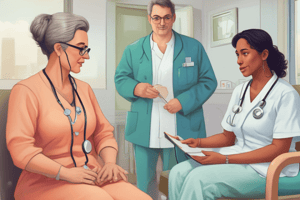Podcast
Questions and Answers
During which phase of the helping relationship is the client's name, address, and medical history gathered?
During which phase of the helping relationship is the client's name, address, and medical history gathered?
Which of the following is NOT a factor influencing communication, based on the information provided?
Which of the following is NOT a factor influencing communication, based on the information provided?
What is the primary purpose of the working phase of the helping relationship?
What is the primary purpose of the working phase of the helping relationship?
Which of the following communication techniques is most likely to create an open and inviting atmosphere for the client?
Which of the following communication techniques is most likely to create an open and inviting atmosphere for the client?
Signup and view all the answers
Which option demonstrates a barrier to the helping relationship, as illustrated in the text?
Which option demonstrates a barrier to the helping relationship, as illustrated in the text?
Signup and view all the answers
Which of the following is NOT a type of data gathered during the Pre-Interaction Phase?
Which of the following is NOT a type of data gathered during the Pre-Interaction Phase?
Signup and view all the answers
What is the purpose of the termination phase of the helping relationship?
What is the purpose of the termination phase of the helping relationship?
Signup and view all the answers
Which of the following is considered subjective data in health history taking?
Which of the following is considered subjective data in health history taking?
Signup and view all the answers
What does the review of systems in health history aim to accomplish?
What does the review of systems in health history aim to accomplish?
Signup and view all the answers
What is included in the components of health history taking regarding past illnesses?
What is included in the components of health history taking regarding past illnesses?
Signup and view all the answers
In the health history assessment process, which component assists in understanding a patient's social context?
In the health history assessment process, which component assists in understanding a patient's social context?
Signup and view all the answers
The chief complaint section should primarily include what type of information?
The chief complaint section should primarily include what type of information?
Signup and view all the answers
Which of the following is NOT considered a core requirement for a helping relationship?
Which of the following is NOT considered a core requirement for a helping relationship?
Signup and view all the answers
Which of the following is considered an objective piece of data in a patient's health history?
Which of the following is considered an objective piece of data in a patient's health history?
Signup and view all the answers
Based on the text, what is the primary role of the nurse in establishing a helping relationship?
Based on the text, what is the primary role of the nurse in establishing a helping relationship?
Signup and view all the answers
In the context of the helping relationship, what is the significance of 'use of self'?
In the context of the helping relationship, what is the significance of 'use of self'?
Signup and view all the answers
A client reports feeling overwhelmed and anxious about their upcoming surgery. Which response from the nurse demonstrates empathy?
A client reports feeling overwhelmed and anxious about their upcoming surgery. Which response from the nurse demonstrates empathy?
Signup and view all the answers
Which statement BEST describes the concept of non-judgmental response in the helping relationship?
Which statement BEST describes the concept of non-judgmental response in the helping relationship?
Signup and view all the answers
In the context of the helping relationship, why is active listening crucial?
In the context of the helping relationship, why is active listening crucial?
Signup and view all the answers
Which scenario BEST demonstrates a breach of good communication in the helping relationship?
Which scenario BEST demonstrates a breach of good communication in the helping relationship?
Signup and view all the answers
Which statement accurately describes the concept of 'nurturing faith and hope' in the helping relationship?
Which statement accurately describes the concept of 'nurturing faith and hope' in the helping relationship?
Signup and view all the answers
Based on the text, what is the essential goal of the helping relationship?
Based on the text, what is the essential goal of the helping relationship?
Signup and view all the answers
Match the following types of data with their appropriate descriptions:
Match the following types of data with their appropriate descriptions:
Signup and view all the answers
Match the phases of the helping relationship with their respective descriptions:
Match the phases of the helping relationship with their respective descriptions:
Signup and view all the answers
Match the following barriers to communication with their examples:
Match the following barriers to communication with their examples:
Signup and view all the answers
Match the following communication techniques with their properties:
Match the following communication techniques with their properties:
Signup and view all the answers
Match the factors influencing communication with their definitions:
Match the factors influencing communication with their definitions:
Signup and view all the answers
Objective data in health history taking includes the client's feelings and emotions.
Objective data in health history taking includes the client's feelings and emotions.
Signup and view all the answers
The working phase of the helping relationship focuses primarily on the exploration of thoughts and feelings.
The working phase of the helping relationship focuses primarily on the exploration of thoughts and feelings.
Signup and view all the answers
Closed or direct questions are best used to build rapport and encourage open conversation.
Closed or direct questions are best used to build rapport and encourage open conversation.
Signup and view all the answers
The termination phase of the helping relationship involves providing the client with referral options and tools for independence.
The termination phase of the helping relationship involves providing the client with referral options and tools for independence.
Signup and view all the answers
Subjective data is generally more quantifiable and is gathered during the pre-interaction phase.
Subjective data is generally more quantifiable and is gathered during the pre-interaction phase.
Signup and view all the answers
During the pre-interaction phase, data gathering includes the client's name, address, age, and ______ history.
During the pre-interaction phase, data gathering includes the client's name, address, age, and ______ history.
Signup and view all the answers
In the context of the helping relationship, ______ data refers to information that is subjective and includes feelings and emotions expressed by the client.
In the context of the helping relationship, ______ data refers to information that is subjective and includes feelings and emotions expressed by the client.
Signup and view all the answers
The termination phase of the helping relationship provides the client with tools necessary for ______, allowing them to manage their needs independently.
The termination phase of the helping relationship provides the client with tools necessary for ______, allowing them to manage their needs independently.
Signup and view all the answers
The working phase focuses on the exploration and understanding of the client's thoughts and ______.
The working phase focuses on the exploration and understanding of the client's thoughts and ______.
Signup and view all the answers
Objective data is generally considered to be ______ and can be verified through measurement and observation.
Objective data is generally considered to be ______ and can be verified through measurement and observation.
Signup and view all the answers
Study Notes
Motivational Activity
- A motivational activity using paper shapes was presented.
Health Assessment Unit 1: Interpersonal Relationship in Nursing
- The unit is about interpersonal relationships in nursing.
- The presentation was given on January 2nd, 2025.
- The presenter is Mrs. Keron Jones-Fraser, PhD.
- The presenter is a candidate with a Master of Science in Nursing (MSCN), Bachelor of Science in Nursing (BScn), and a Certificate in Education (Cert Ed).
- The presenter is a registered nurse (RN).
Objectives
- At the end of the three-hour session, learners will be able to:
- Describe the communication process, noting factors influencing communication.
- Discuss types of communication and tools used for effective communication.
- Describe the methods used by members of the healthcare team.
- Define the helping relationship and common components.
- Identify the four phases of the helping relationship.
- Discuss barriers to a nurse-patient relationship.
- Discuss health history taking processes.
Communication
- Communication is any method for exchanging information or feelings amongst two or more people.
- It's fundamental to human relationships, including nursing.
- Communication is influenced by the sender, the message, and the receiver.
- Effective communication includes feedback.
- Communication can be learned.
- Sending involves both verbal and nonverbal communication.
- Receiving involves interpreting the message.
Communication Process
- The communication process involves a sender, a message, a medium/channel, barriers, and a receiver.
- Feedback is part of the process.
Communication Process (Components)
- Message (written, oral, or nonverbal): the information the sender sends.
- Words and tone.
- Method or organization of message.
- Sound of voice and emotional impact.
- Style of speaking.
- Purpose (to inform or convince).
Verbal Communication
- Conscious use of spoken or written words.
- Word choice reflects a person's age, education, development, and culture.
- Tone, pace, etc., convey feelings.
- Verbal communication includes oral reports to other nurses and writing care plans.
Nonverbal Communication
- Use of gestures, expressions, and behaviors.
- Nonverbal communication is often less conscious.
- Reinforces or contradicts verbal messages.
- Requires careful observation for valid interpretation.
- Personal style affects nonverbal communication.
Nonverbal Communication (Subcomponents)
- Posture and gait.
- Facial expressions.
- Hand movements and gestures.
- Touch (comfort, love, affection, security).
- Eye contact (respect, willingness to listen).
- Blank stares can indicate daydreaming.
- Gestures vary by culture and circumstance (e.g., thumbs up for victory).
- How a person looks (physical appearance), is altered in illness.
Nonverbal Communication (Continued)
- Dress and grooming demonstrates self-esteem.
- Sounds (crying, sighing) are nonverbal communication.
- Silence is also nonverbal.
- Different nonverbal behaviors can illustrate a patient's feelings (e.g., closing eyes, looking away) and how health professionals can respond.
Activity: Communication
- A video on communication techniques is available.
- List breaches and discuss communication observed in a video.
- A specific YouTube video link is provided. (HTTPS://YOUTU.BE/W54YHHZ9DOQ)
The Helping Relationship
- Interpersonal relationships that result in harmony and healing.
- Develops over minutes or weeks.
- Helps patients manage problems by developing unused and underused opportunities, leading to better daily life skills.
The Helping Relationship (Nurse's Role)
- Being sensitive to self and others.
- Assisting with the gratification of patients' physical, emotional, and spiritual needs.
The Helping Relationship (Nurse's Role - Fostering)
- Develop mutual trust, respect, and acceptance.
- Believe in caring for and helping the patient.
- Nurture faith and hope.
The Helping Relationship (Nurse's Limitations)
- Difficulties in understanding patients.
- Potential for gaps in interpersonal communication.
Requirements of the Helping Relationship
- Helping clients identify their feelings.
- Active listening.
- Empathy.
- Sympathy.
- Nonjudgmental responses.
- Establishing trust (sincerity, consistency, competence, reliability, commitment, integrity).
- Using self.
- Understanding of roles and statuses affect the relationship.
Phases of the Helping Relationship
- Four sequential identifiable tasks and skills.
- Progression in the phases where each is a foundation for the next.
Phases of Therapeutic Nurse-Client Relationship
- Pre-interaction stage.
- Orientation/ Introductory period.
- Working stage.
- Termination stage.
Phases of a Helping Relationship - Pre-Interaction Phase
- Client data gathering: name, address, age, and medical history; social history
- Develop plan with possible concerns considered
Phases (Introductory/Orientation Phase)
- Begin nurse/client relationship.
- Clarify problems.
- Develop a contract outlining obligations.
Phases (Working Phase)
- Explore thoughts and feelings.
- Begin taking action.
Phases (Termination Phase)
- End the relationship.
- Give the client tools for independence.
- Offer referral as optional.
Factors Influencing Communication
- Communicator's ability.
- Values and perceptions.
- Developmental level.
- Personal space.
- Roles and relationships.
- Time.
- Environment.
- Attitudes.
- Emotions and self-esteem.
Barriers to the Helping Relationship
- Change in environment (unfamiliar people, places, language, activities).
- Change in role and status.
- Additional barrier factors are described:
- Lack of time, and stress levels affect communication.
Communication Techniques (Video)
- Access to communication technique video online.
- List breaches and discuss communication observed in a video.
- A specific YouTube video link is provided. (HTTPS://YOUTU.BE/W54YHHZ9DOQ)
Communication Techniques - Open-ended Questions
- Asks for narrative information.
- States topic in general terms.
- Use to begin interview or when introducing a new topic.
- Unbiased and enhances rapport.
Communication Techniques - Closed/Direct Questions
- Asks a yes or no.
- Used for specific information and details when necessary.
- Limits depth of interaction and rapport.
Therapeutic Communication Techniques
- Accepting
- Nodding
- Broad openings
- Encouraging expressions
- Exploring
- Focusing
- Giving information
- Giving recognition
- Making observations
- Offering self
- Presenting reality
- Reflecting
Therapeutic Techniques Continued
- Restating
- Seeking information
- Silence
- Summarizing
Ineffective Communication
- Failure to perceive the patient as a person.
- Failure to listen.
- Inappropriate comments or questions.
- Using clichés.
- Using yes/no questions.
- Using questions like "why?".
- Using leading questions.
- Making judgmental comments.
- Changing the subject.
- Aggressive behavior.
- Giving advice.
- Using authority.
- Using avoidance language.
- Engaging in distancing.
Ineffective Communication -Continued
- Using professional jargon inappropriately.
- Using leading or biased questions.
- Talking too much.
- Interrupting.
- Asking "why".
- Additional ineffective communication techniques described.
- Providing reassurance or assurance that isn't helpful, such as, "don't worry, you'll be alright".
- Giving advice or taking over control, instead of allowing the patient to express their concerns.
- Using authority to silence the patient's concerns, such as, "your doctor knows best."
- Avoidance language, using euphemisms that do not face reality.
- Engaging in distancing, creating a barrier, using disengaged speech.
- Using professional jargon.
Scenario
- Student is observing a physician, nurse, client meeting.
- Update on client's medical condition (malignant mass, chemotherapy).
- Prognosis is guarded due to cancer stage.
- Specific examples of the scenario are provided.
- The meeting involved a physician, a nurse/midwife, and the patient's wife and was to update the health status of the patient.
Scenario (Discussion Questions)
- Interpret non-verbal behavior of the client.
- Evaluate the nurse's caring and comforting response.
- Importance of nurse's communication for the client.
- Actions that show thoughtful listening of the nurse.
- Further discussion questions included.
- Patient behavior/response, nurse response, need for communication and reasons, and demonstrating attentive listening are all part of the further discussion questions.
Communicating with Other Health Team Members
- Essential for effective patient care.
- Formal and informal communication methods.
- Communication aids include records, conferences, reports, consultations, referrals, patient rounds, and follow-up care. - Examples of helpful tools are listed.
- Specific communication tools are mentioned.
Health History Taking
- Collecting client-specific information.
- Collect data.
- Establish trust and rapport.
- Teach the patient.
- Promote a continuing relationship for better health.
Health History Preparation
- Prepare the time and environment to ensure privacy and comfort of the patient.
- Review available information (lab reports, admission notes etc.).
- Prepare an interview guide (consider family history, etc.).
Health History (Subjective Data)
- Patient's experiences (feelings), symptoms (itching, pain, fear, etc.).
- Distinction between subjective and objective data is highlighted.
Health History Components
- Sequence of information:
- Biographical data.
- Reason for seeking care.
- History of present illness.
- Past health history.
- Family history.
- Review of systems.
- Functional assessment/ activities of daily living (ADLs).
- Additional information on these components is given.
Health History Components (Example)
- General information/ biographic data and examples.
- Chief complaint(s)-Clear chronological details with examples
- Present illness including medications, allergies, and alcohol/drug use. Examples are provided
- Past illnesses and examples are listed
- Family history with examples
- Review of systems with each system further broken down into subcategories and examples provided.
- Lifestyle/ Health Practices and examples are given.
- Health History Record with a complete list of record components and examples.
- Subjective vs. Objective Data with descriptions of examples.
- Sequence for Taking Health Histories with a definitive sequence and detailed examples (e.g. biological data, chief complaint, and relevant history of the present illness).
- Further updated information provided.
Sequence for Taking Health Histories
- Comprehensive and detailed sequence for taking health histories is included, including examples of each component.
Additional information, including examples are included for the various components of the health history.
Studying That Suits You
Use AI to generate personalized quizzes and flashcards to suit your learning preferences.
Related Documents
Description
Explore the vital aspects of interpersonal relationships in nursing. This quiz will cover the communication process, tools used for effective communication, and the phases of the helping relationship. Enhance your understanding of nurse-patient interactions and barriers within healthcare teams.




